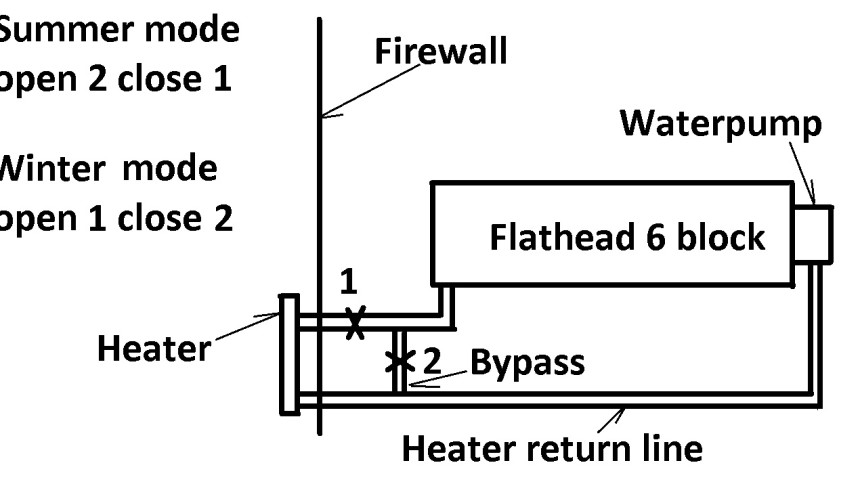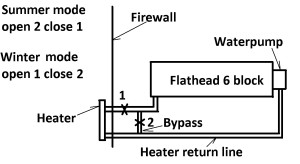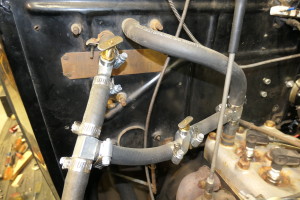Driving Your Plymouth During The Warm Months – Part II
More articles in our “keeping cool” series covered water pumping capacity for the flathead 6. This time we move on to another typical cooling issue with old cars especially early Plymouth and Dodge flathead sixes: block coolant flow distribution and the efforts to Improving Water Distribution to Keep Your (Engine) Cool.
If you want to learn how to help your Plymouth keep it’s cool during those long, hot summer months, read on!
Next Stop: improved coolant water distribution
Owners of later model Flathead 6 engines may notice a water distribution tube located in the block right behind the water pump. This long perforated tube extends from the water pump outlet all the way to the end of the block.
It appears that Plymouth engineers eventually decided there was a need to force the cooled water from the water pump outlet to the back of the block. They put in sort of a a tunnel directing the cooled coolant to the back of the block. Perforations in the “tunnel” bled off a coolant along the way to improve cooling distribution.
The temperature sending unit was placed at the back of the block, furthest from the water pump. It seems that the Plymouth engineers must have determined the back of the block was the hottest location, and just the spot to gather temperature data. You can easily verify this yourself with today’s hand-held temp measuring instrument by scanning the entire block for hot spots.
Do you see wear with 5 and 6?
If you have disassembled a significant number of Plymouth flathead sixes (as I have) you may have noticed that number 5 and 6 piston cylinders tend to show more wear than the other cylinders. I always suspected that the hotter temperatures back there may have contributed to that heavy wear.
The “dead end” being at the back of the block and the hottest fluid at that location turned out to be an opportunity for the Plymouth engineers to tap hot coolant at that point and run it into the interior heater coil for heating the passenger compartment on very cold days. A shutoff valve installed in the water heater hose (leading from the back of the block to the heater) controlled flow to the heater to insure no flow into the passenger compartment on hot summer days.
When that heater hose valve was open there was a very positive flow distribution effect on coolant flow to the back of the block since the block’s “dead end” was gone when fluid raced from the block to the heater. This positive effect however is lost when the heater flow control valve is closed especially if it occurs when the block is running excessively hot.
If you have no shutoff valves in any portion of the heater coolant circuit then you have hot coolant running thru at all times and into the passenger compartment. Your only choice to improve coolant flow to the back of the block appears to be to keeping the “tunnel” clean and the coolant flowing. However do you really want hot coolant running into the heater circuit in the summer and heating up the passenger compartment?
Keep It Positive (Year Round!)
Adding a couple of tees in the heater hoses and some other shutoff valves gives you an opportunity to enjoy the full positive block water distribution effects of taking the coolant off the back off the block year round and circulating back to the water pump inlet. Essentially these tees and shutoff valves allow you to bypass the heater in the car and still circulate coolant to the water pump inlet.
The result of adding the hot coolant bypass improves block temperature distribution and lower water coolant temperatures at the back of the block.
– Don




Aloha Don,
Good article regarding the bypassing of the heater core. Makes sense – Even an old dumb white haired, wrinkly farm boy like myself can understand the reasoning. Well, so much for the heater shut off valve that screws on the top/back of the cylinder head.
Your article mentions the use of a couple of tees and shut off valves to re-circulate the water from the back of the head. Are the tees and shut off valves two separate items or does any manufacturer combine the two into one?
Everything works on the old girl (1940 Plymouth P10 Deluxe woody station wagon) including the heater and defroster, but there is no need for these two functions in Hawaii. Keeping myself and the engine operating temperature as low as possible is far more important. My main concern is not cluttering up an otherwise very sanitary engine compartment.
Mahalo and Malama Pono (Take Care)
Anson Lisk
Ewa Beach, Hi
Your 40 Plymouth Woody (and you) are living in a prime spot for using this bypass method.
I added a picture of an installation to answer your question about one method of using the tees and shutoff valves.
I am not aware of a dual purpose heater hose shutoff/tee but that doesn’t mean they do not exist; just haven’t tripped over it myself….yet.
Imagine a “swing valve” that directed flow one way or another!! Two would do the job!! Like a dryer vent damper.
Let us know if you spot such a thing.
Don
Mahalo Don,
Your picture is worth a thousand words. Is the flow direction to the heater core critical? Currently the coolant from the cylinder head goes to the bottom heater core nipple and exits through the top. In essence this is backwards from your attached picture. It then goes through a valve (attached to the engine compartment firewall) that l am unable to figure out as its has no control mechanizm. The heater hose exits and goes to the water pump return. The valve also has another 5/8″ outlet that is sealed. Looks like a diaphragm of some sort. I tried too attach a picture of the of the valve, but I was unable to do so.
Mahalo again for your help and I hope this note finds you well.
Regards,
Anson
“Is the flow direction to the heater core critical? ”
Critical to?:
1) Collection of deposits in the bottom of the heater core or
2) Heater transfer efficiency into interior or
3) Heater core integrity
Fun topics!
Remember first that a shutoff valve whether at the upper or lower heater core connections —–stops flow thru the heater core. Makes no difference as to flow direction or valve location.
So what were the engineers thinking 7 decades ago about heater core efficiency , integrity, and/or collection of deposits in the heater core bottom?
Well if they thought that a heater core was naturally hotter at the top then at the bottom (due to heat normally rising); they might be inspired to send the hottest fluid coming from the block to the heater core bottom to heat up the lower part of the heater to get a more even temperature distribution from top to bottom to prevent cyclic induced stress fatique cracking of the heater core solder connections = heater core integrity = flow introduced in the bottom is best condition.
Then there would be another thinking that flow from top to bottom with a quick turn going out the bottom might encourage particulates to drop out and start the clogging process of the heater core = collection of deposits = eventually heater core failure= flow introduced in the bottom is best condition.
And of course there would be still yet another pointing out that flow introduced into the top of the core where it’s normally hotter due to rising temps and coming out the bottom where it’s the coolest might drop the temperature of the coolant the most. Since extracting heat is related to how much the heater core reduces the coolant temperature then maybe heater core efficiency would be higher = flow introduced in the top is best condition.
The only winner in the that circle might be the person who was just being born since the more critical item might not be known for decades into the future. Just what was the most critical element needed experimentation and long term testing.
My vantage point & experience says that deposits collecting in the heater core have turned out to be the biggy for all the vehicles that have crossed my paths followed by leaking heater cores which were not far behind on the ugly list to address and fix.
So introducing the flow into the bottom would be my choice technique. What’s your experience?
ps: we excluded mouse nests since that’s probably unrelated to flow direction.
Aloha Don,
O.K. you have my vote. Have you considered running for president. The bottom heater core inlet is the way to go. It’s going to be the same number of bypass valves which ever direction one chooses. The only other option (in Hawaii) is to bypass the heater core all together, and recirculate the coolant directly from the cylinder head to the water pump return.
I’ll draw a diagram how to hook the heater back up, and then I want to live long enough so I can sit down with a beer and watch the oldest boy and grand kids try to hook the heater back up. Should be interesting.
Take care,
Anson
Also consider that an idle heater core can become clogged/corroded over time if not completely flushed chemically and/or by passing fresh coolant thru it occasionally. The bypass method allows for occasional coolant flushing. Additives in the coolant help fight corrosion in the tight heater core passages. So I’d advise the bypass setup to allow for quick flushing a couple of times a year of the heater core….or when climate changes suggest heat in the interior is a good thing! Today’s coolant is great compared to 7 decades ago for fighting off corrosion (if coolants are maintained with recommended flushes).
I have enough leaks from the original radiator to take care of flushing needs!!!
ps: no desire to become a president but maybe that’s the kind of president we need??? Do not waste your vote on me however as the voting this time around needs to be decisive across the U.S.A.; we need to insure we elect (by a large margin) a solid person with the needed critical positive character traits & the required leadership skills by a significant/unquestionable voter statement so the electoral vote doesn’t reverse the popular vote.